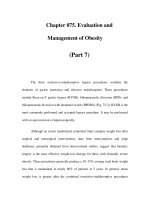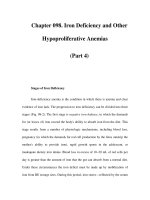Chapter 098. Iron Deficiency and Other Hypoproliferative Anemias (Part 7) pdf
Bạn đang xem bản rút gọn của tài liệu. Xem và tải ngay bản đầy đủ của tài liệu tại đây (13.35 KB, 5 trang )
Chapter 098. Iron Deficiency and Other
Hypoproliferative Anemias
(Part 7)
The second condition is the anemia of chronic inflammation with
inadequate iron supply to the erythroid marrow. The distinction between true iron-
deficiency anemia and the anemia associated with chronic inflammation is among
the most common diagnostic problems encountered by clinicians (see below).
Usually the anemia of chronic inflammation is normocytic and normochromic.
The iron values usually make the differential diagnosis clear, as the ferritin level is
normal or increased and the percent transferrin saturation and TIBC are typically
below normal.
Finally, the myelodysplastic syndromes represent the third and least
common condition. Occasionally, patients with myelodysplasia have impaired
hemoglobin synthesis with mitochondrial dysfunction, resulting in impaired iron
incorporation into heme. The iron values again reveal normal stores and more than
an adequate supply to the marrow, despite the microcytosis and hypochromia.
Iron-Deficiency Anemia: Treatment
The severity and cause of iron-deficiency anemia will determine the
appropriate approach to treatment. As an example, symptomatic elderly patients
with severe iron-deficiency anemia and cardiovascular instability may require red
cell transfusions. Younger individuals who have compensated for their anemia can
be treated more conservatively with iron replacement. The foremost issue for the
latter patient is the precise identification of the cause of the iron deficiency.
For the majority of cases of iron deficiency (pregnant women, growing
children and adolescents, patients with infrequent episodes of bleeding, and those
with inadequate dietary intake of iron), oral iron therapy will suffice. For patients
with unusual blood loss or malabsorption, specific diagnostic tests and appropriate
therapy take priority. Once the diagnosis of iron-deficiency anemia and its cause is
made, there are three major therapeutic approaches.
Red Cell Transfusion
Transfusion therapy is reserved for individuals who have symptoms of
anemia, cardiovascular instability, continued and excessive blood loss from
whatever source, and require immediate intervention. The management of these
patients is less related to the iron deficiency than it is to the consequences of the
severe anemia. Not only do transfusions correct the anemia acutely, but the
transfused red cells provide a source of iron for reutilization, assuming they are
not lost through continued bleeding. Transfusion therapy will stabilize the patient
while other options are reviewed.
Oral Iron Therapy
In the asymptomatic patient with established iron-deficiency anemia,
treatment with oral iron is usually adequate. Multiple preparations are available,
ranging from simple iron salts to complex iron compounds designed for sustained
release throughout the small intestine (Table 98-5). While the various preparations
contain different amounts of iron, they are generally all absorbed well and are
effective in treatment. Some come with other compounds designed to enhance iron
absorption, such as ascorbic acid. It is not clear whether the benefits of such
compounds justify their costs. Typically, for iron replacement therapy, up to 300
mg of elemental iron per day is given, usually as three or four iron tablets (each
containing 50–65 mg elemental iron) given over the course of the day. Ideally,
oral iron preparations should be taken on an empty stomach, since foods may
inhibit iron absorption. Some patients with gastric disease or prior gastric surgery
require special treatment with iron solutions, since the retention capacity of the
stomach may be reduced. The retention capacity is necessary for dissolving the
shell of the iron tablet before the release of iron. A dose of 200–300 mg of
elemental iron per day should result in the absorption of iron up to 50 mg/d. This
supports a red cell production level of two to three times normal in an individual
with a normally functioning marrow and appropriate erythropoietin stimulus.
However, as the hemoglobin level rises, erythropoietin stimulation decreases, and
the amount of iron absorbed is reduced. The goal of therapy in individuals with
iron-deficiency anemia is not only to repair the anemia, but also to provide stores
of at least 0.5–1.0 g of iron. Sustained treatment for a period of 6–12 months after
correction of the anemia will be necessary to achieve this.
Table 98-5 Oral Iron Preparations
Generic Name
Tablet (Iron
Content), mg
Elixir (Iron Content),
mg in 5 mL
325 (65) 300 (60) Ferrous sulfate
195 (39) 90 (18)
Extended release
525 (105)
Ferrous fumarate
325 (107)
195 (64) 100 (33)
Ferrous
gluconate
325 (39) 300 (35)
150 (150) 100 (100) Polysaccharide
iron
50 (50)









